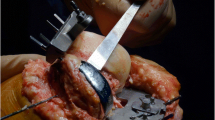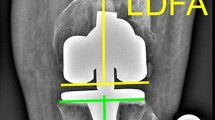Abstract
Revision total knee prosthesis still remains a difficult procedure. Particularly, challenging is the restoration of the joint line to a normal position and the attainment of correct lower limb alignment and healthy bone support for the implants. Computer assistance improves accuracy during the implantation of primary total knees. The goal of this study was to evaluate the usefulness of computer assisted surgery (CAS) in total knee prosthesis revision. We revised 15 NKII total knee arthroplasties with the Navitrack system and compared the mechanical alignment and the joint line level on pre- and postoperative radiographs. After revision, the joint line position was restored. The knee with the revision prosthesis was aligned in the frontal plan with implants fixed perpendicularly to the mechanical axis. It is possible to correctly revise knee prosthesis with computer assistance only and without having to use a conventional ancillary. We had a permanent control of the joint line position and have performed the revision surgery following the same steps as in a primary implantation.


Similar content being viewed by others
References
Bathis H, Perlick L, Tingart M, Luring C, Zurakowski D, Grifka J (2003) Alignment in total knee arthroplasty: a comparison of computer-assisted surgery with conventional technique. J Bone Joint Surg Br 86:682–687
Bolognesi M, Hofmann A (2005) Computer navigation versus standard instrumentation for TKA: a single surgeon experience. Clin Orthop Relat Res 440:162–169
Ecker M, Lotke P, Windsor R (1987) Long term results after total condylar knee arthroplasty. Clin Orthop Relat Res 216:151–158
Figgie H, Goldberg V, Heiple K (1986) The influence of tibial-patellofemoral location on function of the knee in patients with the posterior stabilized condylar knee prosthesis. J Bone Joint Surg Am 68:1035–1040
Hoeffel D, Rubash H (2000) Revision total knee arthroplasty: current rationale and techniques for femoral component revision. Clin Orthop Relat Res 380:116–132
Jenny J, Boeri C (2003) Total knee prosthesis implantation with a non-image-based navigation system: rationale, technique, case-control comparative study with a conventional instrumented implantation. Tech Orthop 18:160–166
Laskin R (2002) Joint line position during revision total knee replacement. Clin Orthop Relat Res 404:169–171
Maculé-Beyneyto F, Hernandez-Vaquero D, Segur-Vilalata J, Colomina-Rodriguez R, Hinarejos-Gomez P, Garcia-Forcada I, Seral Garcia B (2006) Navigation in total knee arthroplasty. A multicenter study. Int Orthop 30:536–540
Mahoney OM, Kinsey T (2006) Modular femoral offset stems facilitate joint line restoration in revision knee arthroplasty. Clin Orthop Relat Res 446:93–98
Mihalko W, Krackow K (2006) Flexion and extension gap balancing in revision total knee arthroplasty. Clin Orthop Relat Res 446:121–126
Nizard R, Porcher R, Ravaud P, Vangaver E, Hannouche D, Bizot P, Sedel L (2004) Use of the cusum technique for evaluation of a CT-based navigation system for total knee replacement. Clin Orthop Relat Res 425:180–188
Partington P, Sawhney J, Rorabeck C, Barrack R, Moore J (1999) Joint line restoration after revision total knee arthroplasty. Clin Orthop Relat Res 367:165–171
Rand J, Ries M, Landis G, Rosenberg A, Haas S (2003) Intraoperative assessment in revision total knee arthroplasty. J Bone Joint Surg Am 85(Suppl 1):26–37
Sierra R, Cooney W, Pagnano M, Trousdale R, Rand J (2004) Reoperations after 3200 revision TKAs: rates, etiology, and lessons learned. Clin Orthop Relat Res 425:200–206
Sikorski J (2004) Computer-assisted revision total knee replacement. J Bone Joint Surg Br 86:510–514
Stöckl B, Nogler M, Rosiek R, Fischer M, Krismer M, Kessler O (2004) Navigation improves accuracy of rotational alignment in total knee arthroplasty. Clin Orthop Relat Res 426:180–186
Whiteside L (2004) A ligament balancing in revision total knee arthroplasty. Clin Orthop Relat Res 423:178–185
Windsor R, Scuderi G, Moran M (1989) Mechanisms of failure of the femoral and tibial components in total knee arthroplasty. Clin Orthop Relat Res 248:15–20
Zumstein M, Frauchiger L, Wyss D, Hess R, Ballmer P (2006) Is restricted femoral navigation sufficient for accuracy of total knee arthroplasty. Clin Orthop Relat Res 451:80–86
Author information
Authors and Affiliations
Corresponding author
Rights and permissions
About this article
Cite this article
de Ladoucette, A. Computer-assisted revision of total knee arthroplasty. Knee Surg Sports Traumatol Arthrosc 17, 1166–1171 (2009). https://doi.org/10.1007/s00167-009-0769-1
Received:
Accepted:
Published:
Issue Date:
DOI: https://doi.org/10.1007/s00167-009-0769-1




